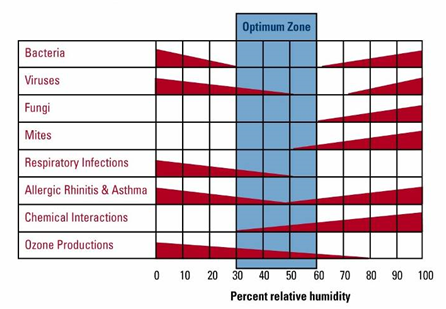
nash
“Indoor Air Quality (IAQ) refers to the air quality within and around buildings and structures, especially as it relates to the health and comfort of building occupants. Understanding and controlling common pollutants indoors can help reduce your risk of indoor health concerns. Health effects from indoor air pollutants may be experienced soon after exposure or, possibly, years later.”
-United States Environmental Protection Agency

“Biological contaminants include bacteria, viruses, animal dander and cat saliva, house dust, mites, cockroaches, and pollen. There are many sources of these pollutants. By controlling the relative humidity level in a home, the growth of some sources of biologicals can be minimized. A relative humidity of 30-50 percent is generally recommended for homes. Standing water, water-damaged materials or wet surfaces also serve as a breeding ground for molds, mildews, bacteria and insects. House dust mites, the source of one of the most powerful biological allergens, grow in damp, warm environments.”
-EPA
Many of these biological contaminants are small enough to be inhaled. Biological contaminants are, or are produced by, living things. Biological contaminants are often found in areas that provide food and moisture or water, like a damp basement or crawlspace.
Some biological contaminants trigger allergic reactions, including:
Infectious illnesses, such as influenza, measles and chicken pox are transmitted through the air. Molds and mildews release disease-causing toxins. Symptoms of health problems caused by biological pollutants include:
“Other health effects may show up either years after exposure has occurred or only after long or repeated periods of exposure. These effects, which include some respiratory diseases, heart disease and cancer, can be severely debilitating or fatal. It is prudent to try to improve the indoor air quality in your home even if symptoms are not noticeable.”
“Children, elderly people and people with breathing problems, allergies, and lung diseases are particularly susceptible to disease-causing biological agents in the indoor air.”
“Mold, dust mites, pet dander and pest droppings or body parts can trigger asthma. Biological contaminants, including molds and pollens can cause allergic reactions for a significant portion of the population. Tuberculosis, measles, staphylococcus infections, Legionella and influenza are known to be transmitted by air.”
For further information please visit the Centers for Disease Control and Prevention HERE and search indoor air quality.
More information can also be found at the United States Environmental Protection Agency HERE.